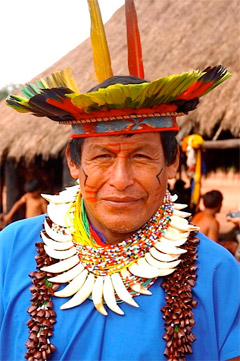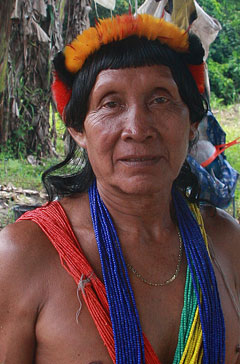Just north of Los Angeles on a bluff overlooking the Pacific Ocean is a special piece of ancient tribal land. Prehistoric artifacts and burials indicate that occupation occurred there as early as 6000 BC. It was this primeval site on a crisp October night recently where the Wishtoyo Foundation and the Chumash people, in cooperation with the Amazon Conservation Team, held “A Summit of Indigenous Spiritual Leaders.”
Since 1996, Dr. Mark Plotkin, President of the Amazon Conservation Team (ACT), has been spearheading programs and initiatives that work closely with these tribal leaders on their lands and creating alliances across cultural, biological, political and economic spectrum. Though this is daunting work to undertake in what are complex tropical environments, his intense, comprehensive, and holistic approach has proven extremely effective in protecting rainforest diversity and its people. This past July, ACT took the lead on a project that aims to prevent deforestation across 46 million ha (114 million acres) in the northeastern and southwestern sections of the Brazilian Amazon. The initiative, partially funded by the Skoll Foundation, which contributed $1.6 million, will “strengthen the capacity of the indigenous communities and government agencies to monitor, manage and protect the indigenous reserves and adjacent areas while creating positive conditions for long-term financing of forest protection,” according to a statement from the Skoll Foundation.
 Don Luciano in Brazil’s Xingu region |
Though deforestation and its impact are widely reported in the media, the destruction to native plants used for medicines by indigenous tribes typically goes unnoticed and is, simply put, catastrophic. This is extinction in its most violent form and one where the axiom, “we don’t know what we don’t know” moronically applies given our collective ignorance of the importance of native flora.
In addition to meeting several shaman at the Summit, I was lucky enough to connect with Dr. Chistopher Herndon, an ethnobotanist and physician at University of San Francisco and a member of ACT. He has been intimately involved in studying shamanic diagnostics and healing in remote indigenous villages deep in the rainforests of the Amazon. His research finds that shamans in the Trio tribe of the northeast Amazon have a complex understanding of disease concepts, one that is certainly comparable to Western medical science. Trio medicine men recognize at least 75 distinct disease conditions—ranging from common ailments like fever [këike] to specific and rare medical conditions like Bell’s palsy [ehpijanejan] and distinguish between old (endemic) and new (introduced since contact with the outside world) illnesses. As Herndon explains, “One cannot ‘save’ the medical systems of indigenous tribes alone through written inventories of their medical plant knowledge. Trio ethnomedicine, not unlike our healing tradition, is a complex art of diagnosis, examination, communication, ritual and treatment that can only be transmitted through active practice. The disintegration of traditional systems of health is most devastating to indigenous peoples, who at the same time often have very limited access to extrinsic medical resources. The adoption by organizations of programs that strengthen and retain tribal peoples’ self-sufficiency is critical for their health as well as to enable the transmission of these remarkable medical systems for the benefit of future generations.”
Thankfully, ACT has been successful in this area as well. ACT places great value on traditional knowledge and culture itself, since this determines community cohesion and unity. The intimate bond between indigenous cultures and the Amazon’s biodiversity expresses itself through our partners’ unparalleled knowledge of forest ecosystems, as well as in their healing traditions and other cultural expressions. This provides yet another reason for working with indigenous communities in conservation – they simply know the land and ecosystems better than anyone on the planet.
 Amasina in Suriname. Photo by Rhett A. Butler |
My chance to meet the tribal elders occurred with the help of Liliana Madrigal, the Director of Program Operations and Co-founder of ACT. Liliana has been working in the conservation field for over two decades, and travels frequently to South America to meet and work directly with ACT’s indigenous partners in the Amazon, notably serving as chief liaison with shamans of the northwest Amazon. Liliana is responsible for the implementation of ACT’s women’s programs, which seek to build esteem, increase sustainable development opportunities and advance human rights among women of indigenous communities across Amazonia. Her initiative encouraged the formation in 2004 of the first full-fledged union of female traditional healers in the Colombian Amazon, the Asociación de Mujeres Indígenas de la Medicina Tradicional.
With Liliana as interpreter, I was able to ask a few questions of several elders from the Ingano tribe of Colombia. What I discovered is perhaps not that surprising, but no less disheartening. Basically, if a foreign corporation wants to explore for oil or other mineral wealth in forest around or on Ingano land, they must work with the Colombian equivalent of our EPA. However, the Colombian “EPA” doesn’t include the tribes in this process and consequently many of these projects, be it drilling or mining, are rubber-stamped approved. What regulation exists is often not enforced and the results aren’t just bad – they are disastrous.
I asked the eldest Ingano, what has most changed since he was a young boy:
“I can talk all day to you…. We had a big piece of land…it was all forest and everything was very traditional. Then they [the government] allowed the petrol companies to come in and afterwards the oil was everywhere. In the rivers, in the creeks, thick like glue (he cupped his hands to show me). I am a traditional medicine man and we used to be able to heal anything. Not now.”
His strong and weathered face told a story that words cannot reveal.
As sun set over the Pacific, Indigenous Healers, Elders, and other spiritual and environmental leaders of indigenous tribes from North America, Amazonia and Polynesia gathered around a fire pit in the main Chumash aps (dwelling). In the hopes of conveying their collective wisdom, scientific knowledge and compassion for humanity, these few remaining leaders sought to reach a broader audience of western guests whose influence could perhaps help reverse the unconscious destruction of an environment and its people. It was clearly an evening to watch and listen. The speeches in English, Spanish or tribal dialect proved poignant and revolved around one common theme – we are all in this together and what happens today affects all of us and the generations that follow. It is time to take notice, awaken, and act consciously. This exactly echoed what Mati Waiya, Director of the Wishtoyo Foundation, and Chumash Village said to a few of us earlier in the evening:
“We may have been separated by race, religion, creed, wealth, or whatever has caused wars in the world, but there is only one world and one people. We need to engage together. It is a responsibility, and something we should never forget. We are deteriorating our own core because we are destroying our own world, and that is not healthy. We need to live, and appreciate our lives, moment to moment. We need to get back to living more natural, more sustainable lives, and to take care of our Mother better, our Mother Nature.”
The messages were clearly effectual as the audience’s awareness was almost palpable; we were ready for more…
The younger generation of the various tribes assumed positions around the fire. In the cool indigo night, a spiritual ceremony of song and dance slowly began to build. We all huddled a little bit closer. Sounds of drumming and chanting reverberated as lithe painted bodies and feathered headdresses swayed in rhythm. The smell of smoke and sage and red-orange fire heightened our senses. Through this timeless and sacred ritual of dance, the “Millennials” of these tribes seemed to embody and communicate a message of hope and reverence for a planet in need. What was heard earlier was now felt. No one left until the last song of prayer was sung. Something tells me 8000 years ago on this very bluff, ceremonies not unlike this one had taken place. Are we the wiser? These ceremonies remind us that something much greater than we can comprehend is at play here. Within that realization, do we embrace humanity – or do we reject it?